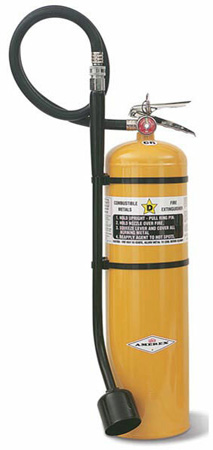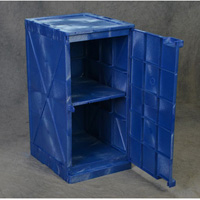



Find all of your laboratory and workplace safety supplies at Safety Emporium!
 IARC |
 Glossary Index |
 Inert |
| MSDS Topics |
Free Sites | FAQ's | Regulations | Glossary | Software | Suppliers |
| Books | Forum | Poll | Fun stuff | Quiz | Store | |
| Understand your MSDS with the MS-Demystifier | Search ALL our MSDS info | |||||

Get your Class D and other specialty extinguishers from Safety Emporium.
Incompatible chemicals give an undesired chemical reaction when mixed. This usually refers to substances that will react to cause an imminent threat to health and safety through an explosion, fire, and/or formation of toxic materials.
The term can also refer to an unwanted change in the physical or mechanical properties of the materials.
Even everyday chemicals have incompatibilities. For example, did you ever notice that containers of bleach have a warning not to mix bleach and ammonia? When mixed, these substances generate the toxic gases chloramine (NH2Cl) and hydrazine (N2H4), which could cause serious injuries or death!
Other examples of incompatibilities include the reaction of alkali metals such as sodium or potassium metal with water. In this case, the products are extremely basic sodium or potassium hydroxide (corrosive), hydrogen gas (explosive) and a lot of heat (an exothermic reaction). The heat generated is so great that the hydrogen generated will usually ignite! See our entry on water reactive chemicals for information on the proper storage of these materials.
Improper storage and disposal of incompatible chemicals has led to a number of accidents. Always properly identify and segregate your chemicals and wastes to avoid the accidental mixing of incompatibles. For example, do not store acids and bases in the same cabinet. Do not store acid waste and organic waste in the same area. See the links under Further Reading for more tips and information.
NOTE: We may collect a share of sales or other compensation from the links in the following list:
Fortunately, chemical incompatibility is one of the items that OSHA requires on a Safety Data Sheet. You will find incompatibility and safe storage/handling information in Section 7 of the sheet (handling and storage). Read your SDS carefully and make sure the labels on the container include warnings about incompatibilities. If the label lacks such warnings, why not add them?
Most mistakes with chemicals happen not when they are being used properly, but when a process or reaction is being cleaned up. This is when most people tend to let their guards down and when a variety of different kinds of chemical substances can be mixed. If some of these are incompatible, look out! Here's one example of what can happen in these kinds of situations. Note the lessons learned and safety tips that accompany this article.

Get your corrosion-resistant polyethylene acid storage cabinets with internal sumps from Safety Emporium.
See also: decomposition, water reactive.
Additional definitions from Google and OneLook.
Entry last updated: Monday, January 2, 2023. This page is copyright 2000-2025 by ILPI. Unauthorized duplication or posting on other web sites is expressly prohibited. Send suggestions, comments, and new entry desires (include the URL if applicable) to us by email.
Disclaimer: The information contained herein is believed to be true and accurate, however ILPI makes no guarantees concerning the veracity of any statement. Use of any information on this page is at the reader's own risk. ILPI strongly encourages the reader to consult the appropriate local, state and federal agencies concerning the matters discussed herein.